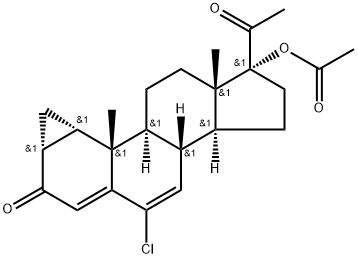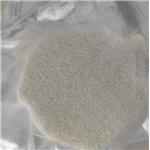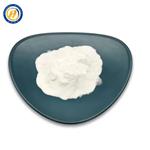Description
Cyproterone acetate (CPA) is an androgen receptor antagonist. It binds to human androgen receptors (K
i = 14 nM) and inhibits dihydrotestosterone-induced androgen receptor activation in CV-1 cells (IC
50 = 26 nM). CPA (30 mg/kg) decreases ventral prostate weight in castrated immature rats. It also suppresses accessory sexual glands and fertility in adult male rats when administered at a dose of 10 mg/kg. CPA (0.3 μM) also induces apoptosis in primary adult female rat hepatocytes. Formulations containing cyproterone acetate have been used in the treatment of androgenization in females.
Chemical Properties
Crystalline Solid
Originator
Androcur ,Schering,W. Germany,1973
Uses
Cyproterone acetate (CPA) has been shown to exert gestagenic and glucocorticoid effects. Because it inhibits the negative diencephalic pituitary testicular feedback system, it lowers luteinizing hormone (LH) and testosterone production and plasma levels. cyproterone acetate is both an anti-androgen and a progestogen. CPA is used in combined birth control pills, in the treatment of androgen-dependent skin and hair conditions such as acne (Combined with estrogen), seborrhea, excessive hair growth, and scalp hair loss, high androgen levels, in transgender hormone therapy, to treat prostate cancer, to reduce sex drive in sex offenders or men with paraphilias or hypersexuality, to treat early puberty, and for other uses. It is used both at low doses and at higher doses.
Definition
ChEBI: Cyproterone acetate is a steroid ester resulting from the formal condensation of the carboxy group of acetic acid with the 17-hydroxy group of cyproterone. It is an antiandrogenic drug which has recently been recognized to promote the occurrence and growth of intracranial meningiomas. It has a role as an androgen antagonist, a progestin and a geroprotector. It is a 20-oxo steroid, a 3-oxo-Delta(4) steroid, a chlorinated steroid, a steroid ester and an acetate ester. It is functionally related to a cyproterone.
Indications
Cyproterone acetate is a progestational antiandrogen
that blocks androgen receptor binding and suppresses
androgen-sensitive tissues. It is available in a
topical form in Europe for the treatment of hirsutism.
Manufacturing Process
2.34 g of 1,2α-methylene-δ4,6-pregnadiene-17α-ol-3,20-dione-17-acetate are
dissolved in 18.25 cc of ethylene chloride which contains 844 rng of
perbenzoic acid. The solution is stored for 16 hours at +5°C and 7 hours at
room temperature. It is then diluted with methylene chloride and, with
aqueous ferrous sulfate solution, sodium bicarbonate solution and with water
washed until neutral.
The organic phase is dried over sodium sulfate and then concentrated to
dryness. 1.62 g of the thus obtained crude 1,2α-methylene-6,7α-oxido-δ4-
pregnene-17α-ol-3,20-dione-17-acetate are dissolved in 109 cc of glacial
acetic acid. This solution is then saturated at room temperature with hydrogen
chloride gas and stored for 20 hours, It is then diluted with methylene
chloride and washed with water until neutral.
The organic phase is dried over sodium sulfate and then concentrated to
dryness. The thus obtained crude 6-chloro-1α-chloromethyl-δ4,6-pregnadiene17α-ol-3,20-dione-17-acetate is heated to boiling in 20 cc of collidine for 20
minutes under nitrogen. After dilution with ether it is washed with 4 N
hydrochloric acid and washed with water until neutral.
After drying over sodium sulfate and concentration to vacuum the remaining
residue is subjected to chromatography over silica gel. Using a benzene-ethyl
acetate mixture (19:1) there is eluated 900 mg of 6-chloro-1,2α-methyleneδ4,6-pregnadiene-17α-ol-3,20-dione-17-acetate, which upon recrystallization
from isopropyl ether melts at 200° to 201°C.
Therapeutic Function
Antiandrogen
Mechanism of action
The mechanism of action of Cyproterone acetate at the molecular level has never been described conclusively. Studies have found that in rat ventral prostate nuclei, CPA interferes with androgen binding to the androgen receptor. It is possible that CPA interferes with the translocation of the androgen receptor from the cytoplasm to the nuclear compartment. At the transcription level, the effects of CPA also include a reduction of androgen-dependent cellular functions, such as a reduction of acid phosphatase, prostate-specific androgen, and androgen-dependent enzymes such as 5-a-reductase[1].
Side effects
Vbreast tenderness and swelling. Tiredness and weakness (fatigue). Depression or mood changes. Hot flushes or sweats. Swelling in parts of the body (fluid build up). Weight changes. Liver changes (you will have regular blood tests to check for this). Shortness of breath.
Metabolism
Cyproterone is metabolised by various pathways including
hydroxylation and conjugation; about 35% of a dose is
excreted in urine, the remainder being excreted in the bile.
The principal metabolite, 15β-hydroxycyproterone, has
anti-androgenic activity
References
[1] Schr?der F, et al. Cyproterone Acetate-Mechanism of Action and Clinical Effectiveness in Prostate Cancer Treatment. Cancer, 1993; 72: 3810-3815.





